The mad dash to scale Everest: Video shows huge ‘traffic jam’ of climbers snaking up ice-covered slopes in ‘weather window rush hour’ as two more go missing days after Brit, 40, and Sherpa disappeared near summit
The route to the summit of Mount Everest is packed with eager climbers frantically rushing to reach the world’s highest point – even as several adventurers and their guides were killed or missing this week.
A shocking video shared on social media showed a series of dozens of climbers snaking up the glacier in the high-altitude ‘death zone’ – so called because the air is so thin that most rely on supplemental oxygen to survive .
The ‘human traffic jam’, recorded on May 20, came when the mountain was experiencing a ‘weather window’ – a brief period of clear conditions when successfully reaching the summit is a less dangerous task.
Forecasters expect the golden window to close by the end of the week, meaning the route to the top is likely to be flooded with potential top athletes desperate to realize their dream for just a few more days.
But the climbers face difficult odds even in the favorable conditions. Authorities announced this morning that a Kenyan climber died near the summit yesterday and that his Nepalese guide has gone missing.
Meanwhile, British climber Daniel Paul Paterson, 40, and his guide Pas Tenji Sherpa, 23, also remain missing after successfully reaching the summit on Tuesday morning, only to find themselves caught in an icefall during their descent just minutes later.
Shocking video shared on social media showed a seemingly endless line of climbers winding their way up the glacier in the high-altitude ‘death zone’ – so called because the air is so thin that most rely on supplemental oxygen to survive
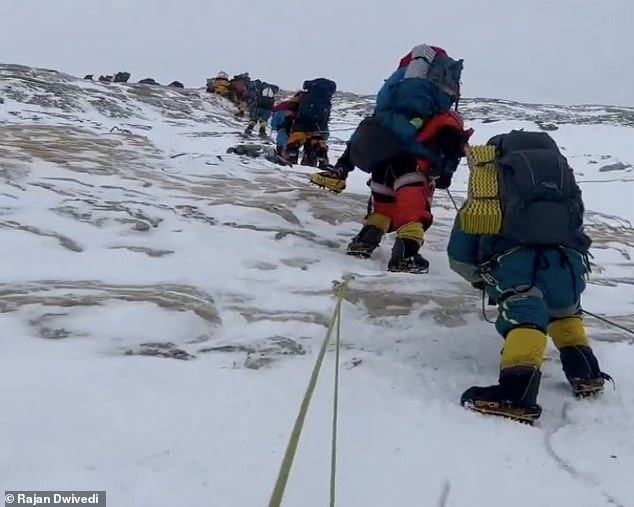
The ‘human traffic jam’, recorded on May 20, came when the mountain was experiencing a ‘weather window’ – a brief period of clear conditions
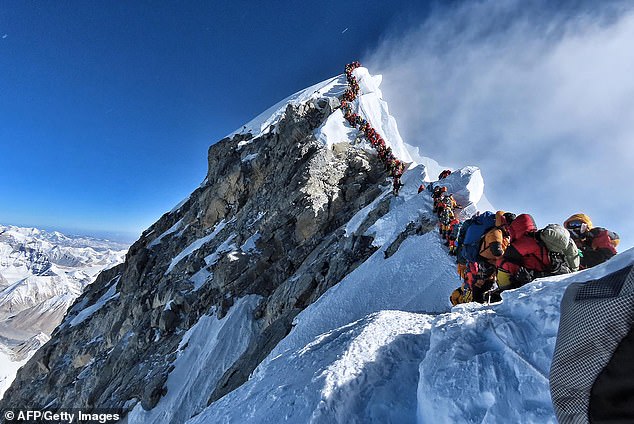
Because climbers can only reach the summit in small weather conditions, queues can form on the mountain, which significantly increases the risk of death
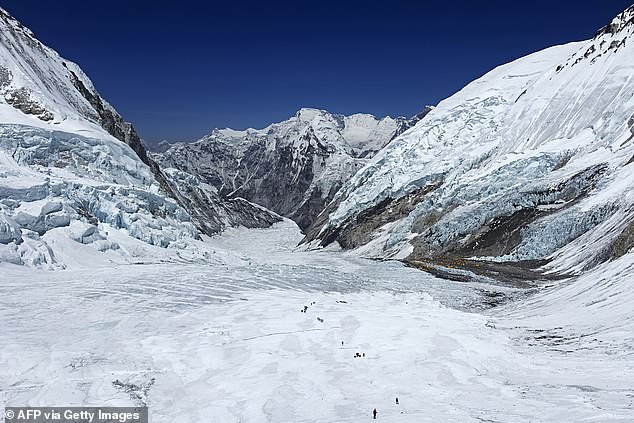
This photo, taken on May 3, 2024, shows mountain climbers on the Khumbu Glacier as they climb to the summit of Mount Everest in Nepal
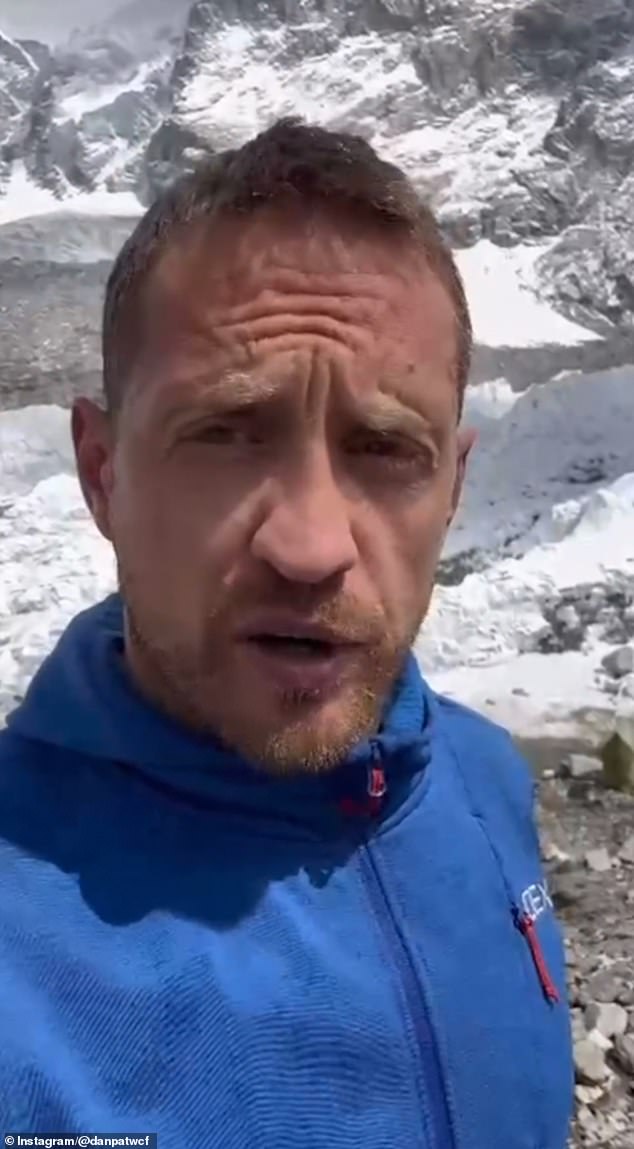
British climber Daniel Paul Paterson, 40, and his guide Pas Tenji Sherpa, 23, also remain missing after successfully reaching the summit on Tuesday morning, only to be caught in an icefall during their descent just minutes later.
Kenyan Joshua Cheruiyot Kirui, 40, and his Nepalese guide Nawang Sherpa, 44, were out of contact on Wednesday morning and a search team was deployed to the 8,849-metre mountain.
“The team found the Kenyan climber dead between the summit and the Hillary Step, but his guide is still missing,” Khim Lal Gautam, head of the tourism department’s field office at the base camp, said this morning.
It was reported that Kirui wanted to reach the summit without supplemental oxygen – a feat that only 221 of the 6,664 people who have reached the summit of Everest have managed to achieve, according to the last count in January 2024.
Rescue teams are also continuing their search for Briton Paterson and his guide, who were both caught up in the sudden icefall on Tuesday.
The shocking collapse is believed to have occurred at Hillary Step, a nearly vertical rock face just below the summit of the world’s highest peak.
“A cornice broke off and washed some climbers, including Daniel and his guide, onto the Tibetan side,” said a member of a team at the Everest base camp The times.
Neither climber has yet been confirmed dead, but hopes are fading that anyone could survive more than a day in the ‘death zone’.
Paterson’s partner Beck Woodhead said yesterday she had not heard from her partner and was waiting for news with their families.
The fitness enthusiast dedicated his climb to a late friend at Wakefield Crossfield Club, which he co-owns, and recently announced that members had raised £10,000 for her family.
An avid climber, he had trained in the Himalayas last year and said he was emotional when he saw the summit of Everest. He told his followers, “My dream will always be to overcome this.”
A Sherpa with Paterson’s group said yesterday that the expedition had successfully reached the summit, before sharing the news that the two men had gone missing during the climb.
“Eyewitnesses reported that the incident occurred between Summit Ridge and South Summit and some climbers were swept away in Kangshung Face,” he said.
“Our dedicated search and rescue teams are deployed to the scene. They are working tirelessly to locate our missing climbers. Our thoughts and prayers are with their families during this challenging time.”
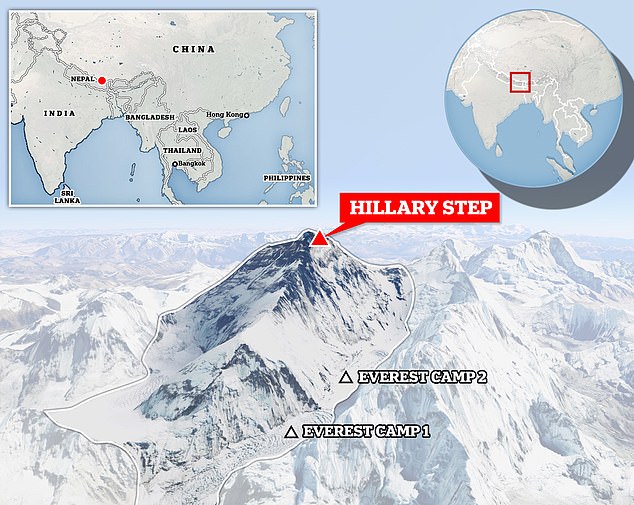
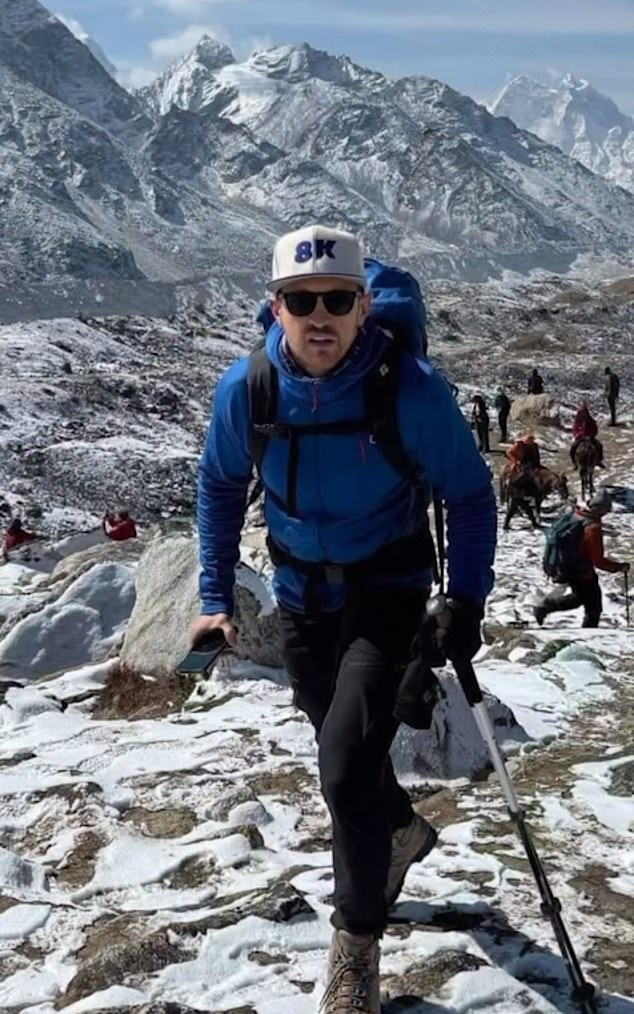
Mr Paterson previously said it had always been his dream to ‘conquer’ the summit of Everest
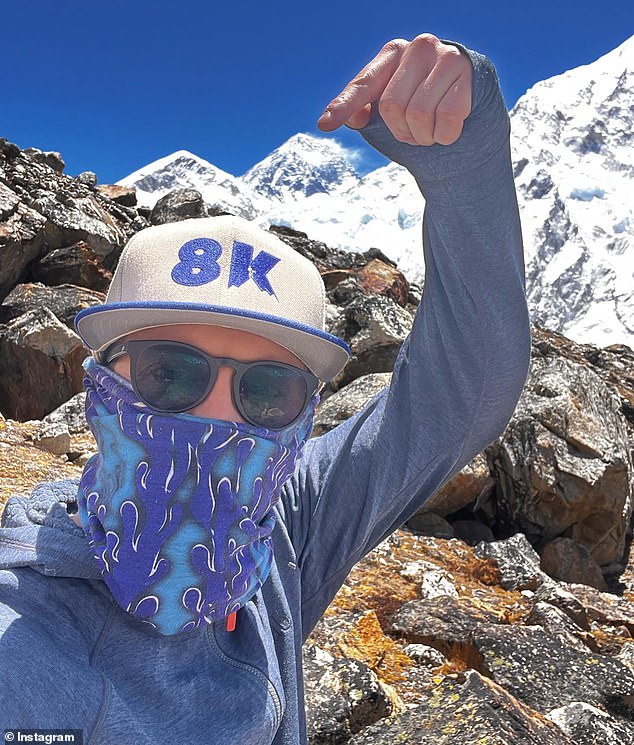
Missing Daniel Paul Paterson, 40, is pictured on May 11 ahead of his climb to the summit

Mr Paterson with his partner Beck Woodhead
The route to Everest and the surrounding peaks is dangerous at the best of times.
On Monday, a Romanian climber died in his tent while attempting to climb Lhotse, the fourth highest mountain in the world.
Everest and Lhotse share the same route until they diverge at about 7,200 meters altitude.
Gabriel Tabara also wanted to climb Lhotse without supplemental oxygen, but Sherpas found his lifeless body in his tent at Camp 3 (located at an altitude of 7,163 meters) on the morning of the planned summit attempt.
Earlier this month, two Mongolian climbers went missing after reaching the summit of Everest and were later found dead.
Two more climbers, a Frenchman and a Nepalese, have died this season on Makalu, the world’s fifth highest mountain.
More than 600 climbers reached the summit of Everest last year, but it was also the deadliest season on the mountain, with 18 fatalities.
Nepal has issued more than 900 permits for its mountains this year, including 419 for Everest, earning more than $5 million in royalties.
More than 500 climbers and their guides have already reached the summit of Everest after a rope repair team reached the summit last month.
This year, China also reopened the Tibetan route to foreigners for the first time since it was closed in 2020 due to the pandemic.
Home to eight of the world’s ten highest peaks, Nepal welcomes hundreds of adventurers every spring, when temperatures are warm and winds are generally calm.
But Everest – the highest and most famous mountain in the world – has exploded in popularity in recent years.
This has provided a welcome economic boost to Nepal and to the guides who spend their lives helping climbers from all corners of the world prepare for and climb Everest and the surrounding mountains.
But it has also given rise to shocking pollution.
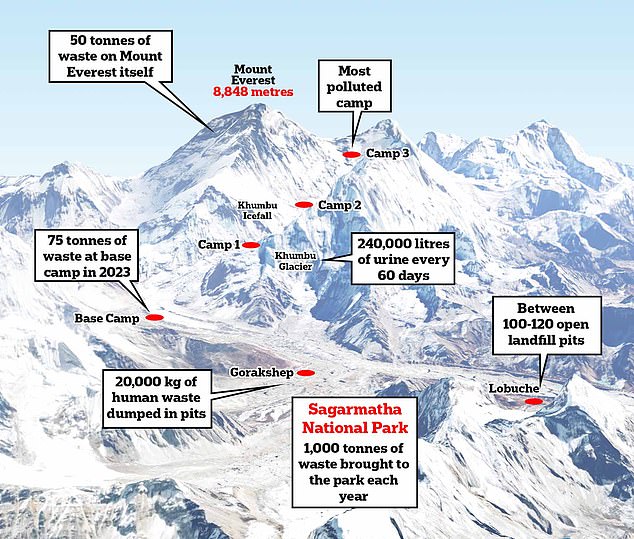
Tourists coming to Mount Everest and the surrounding Sagarmatha National Park bring in an estimated 1,000 tons of waste every year, most of which never leaves the park
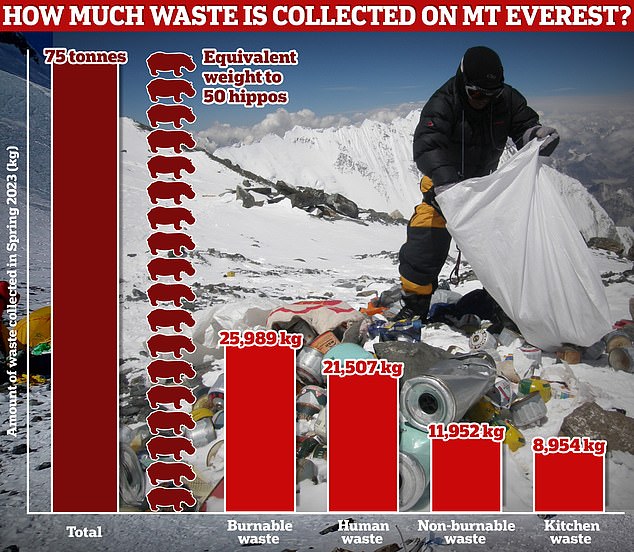
In the spring 2023 climbing season alone, 75 tons of waste was collected at the Everest base camp, including 21.5 tons of human waste dumped in nearby wells.
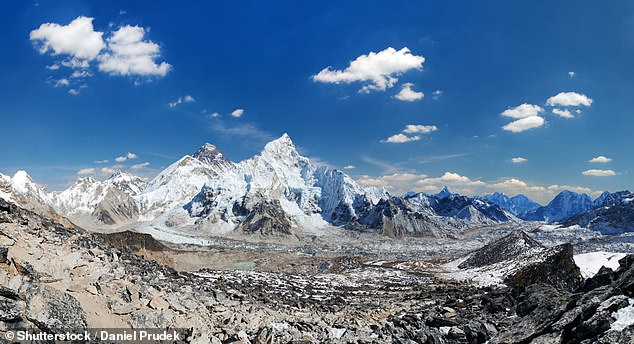
With a height of 8,848 meters, Mount Everest is the highest mountain in the world and continually attracts tourists and climbers from all over the world

At Everest Base Camp (pictured), approximately 2,00 climbers gather each season, generating enormous amounts of waste
Experts estimate that as much as 50 tons of waste remains on the mountain, while Everest Base Camp produces 75 tons of waste each season.
The waste problem is now so bad that climbers will be forced to carry their own poop back down the mountain.
Mount Everest itself is located in the Sagamartha National Park in the Khumbu region of Nepal.
This 124,400-hectare UNESCO World Heritage Site contains some of the world’s highest mountains and some 200 Sherpa villages.
The number of tourists visiting the park had been steadily increasing for years, but over the past decade it skyrocketed, doubling in the three years between 2014 and 2017.
While the park itself is home to a permanent population of just 7,000 people, some 60,000 foreign tourists now visit every year, along with thousands more Nepali guides.
It is now estimated that between 900 and 1,000 tons of solid waste enters the park each year, the vast majority of which never leaves.
The problem became so serious that in 1991 the Sagarmatha Pollution Control Committee (SPCC) was formed to try to get the amount of waste back under control.
The SPCC now manages waste collection from Everest Base Camp and the trails in the national park.
And since 2014, climbers going beyond Base Camp must take 8kg of rubbish with them or risk losing their $4,000 (£2,600) deposit.
